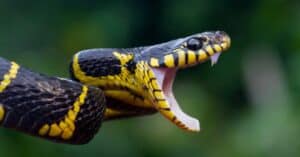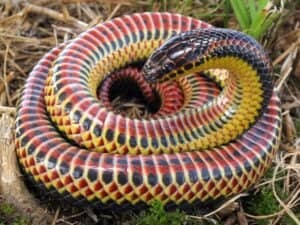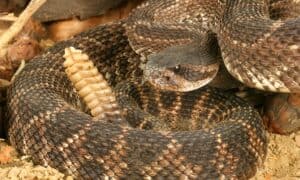What Do Skinks Eat? 20+ Foods They Prefer
Skinks are small lizards that have over 1,000 different species around the world. Unfortunately, some of them are confused for snakes in the wild due to their short necks and short legs which makes them take on a serpent-like movement. These reptiles live around the world, and there are notable differences between species in Asia and those in North America. So, what do skinks eat in the wild?
We’ll help you discover the feeding habits of skinks both in the wild and as pets. We’ll also show you how such odd-looking creatures manage to catch food at all!
What Foods Do Skinks Eat?
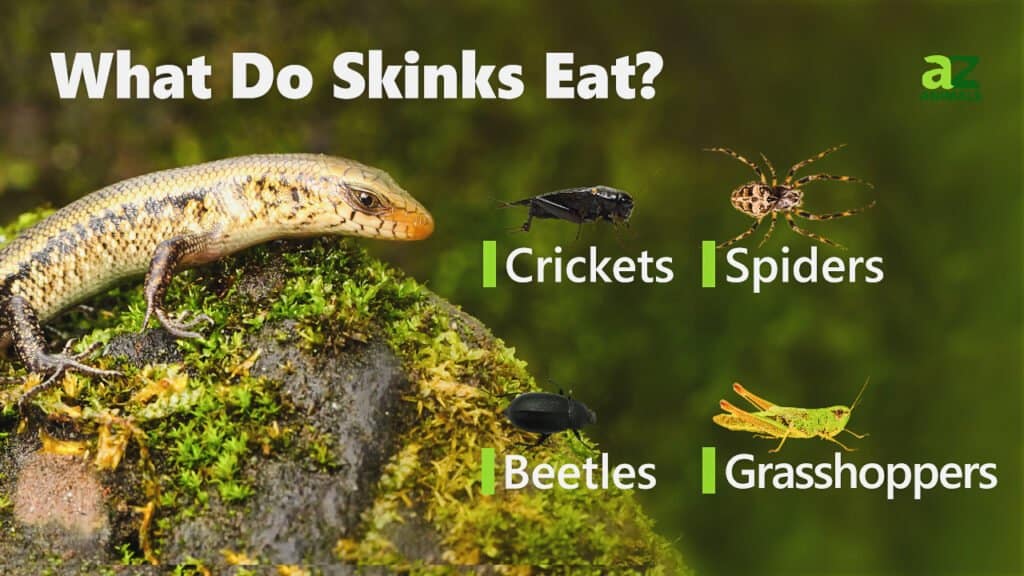
A-Z-Animals.com
Skinks eat insects, mollusks, small mammals, and fruit. These omnivorous lizards primarily focus on eating insects, but some species will also make fruit a significant portion of their diet. With so many different types of food available to them, the skink’s potential diet is highly varied.
Skinks eat all these foods:
- Flies
- Grasshoppers
- Beetles
- Spiders
- Crickets
- Moths
- Earthworms
- Roaches
- Locusts
- Dandelion greens
- Squash
- Caterpillars
- Termites
- Mango
- Raspberries
- Figs
- Papaya
- Small lizards
- Millipedes
- Mice
- Slugs
- Skink eggs (rarely)
The majority of skinks mostly eat insects as part of their diet. However, given that the skink is not well-adapted to hunt down insects, their diet is somewhat flexible.
The differences between types of skinks can be vast in terms of location and physiology. Some skinks are more lizard-like and capable of chasing down a meal while others are more snake-like, and their locomotion is hindered.
How Do Skinks Hunt?
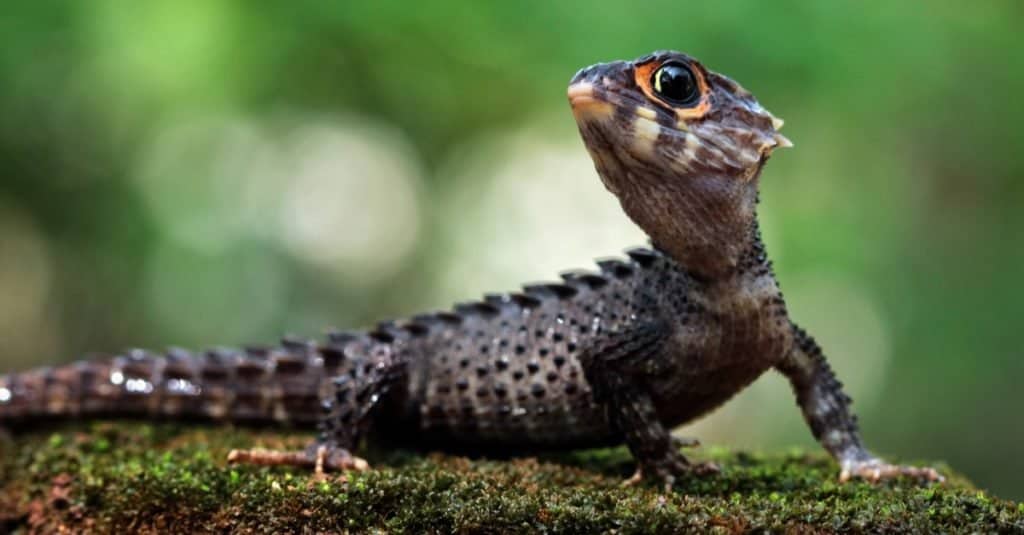
Kurit afshen/Shutterstock.com
As carnivores, skinks have to spend a fair amount of their time hunting for food. They are opportunistic hunters most of the time, meaning they come across prey and eat. Sometimes, they will ambush prey by exploring various crevices where they believe prey could be, especially in the case of crustaceans by the ocean.
One means that skinks use to find prey is their sense of smell. However, the way they smell other creatures is unique. They will flick their tongue and use the chemical cues they gather to determine what is nearby. They can use this ability to sense prey that is close, and they can also use this ability defensively to see if there is a predator in their area.
Finding insects, fruit, and other small lizards is easy when looking for them according to their chemical markers.
Another way that skinks find food is through a sense of detecting vibrations in the ground like many other reptiles. They sense the ground-borne vibrations of nearby creatures to determine if they are something they eat or a creature from which they need to hide.
Even with these adaptations, skinks are not always fast enough or clever enough to land a good meal.
What Do Pet Skinks Eat?
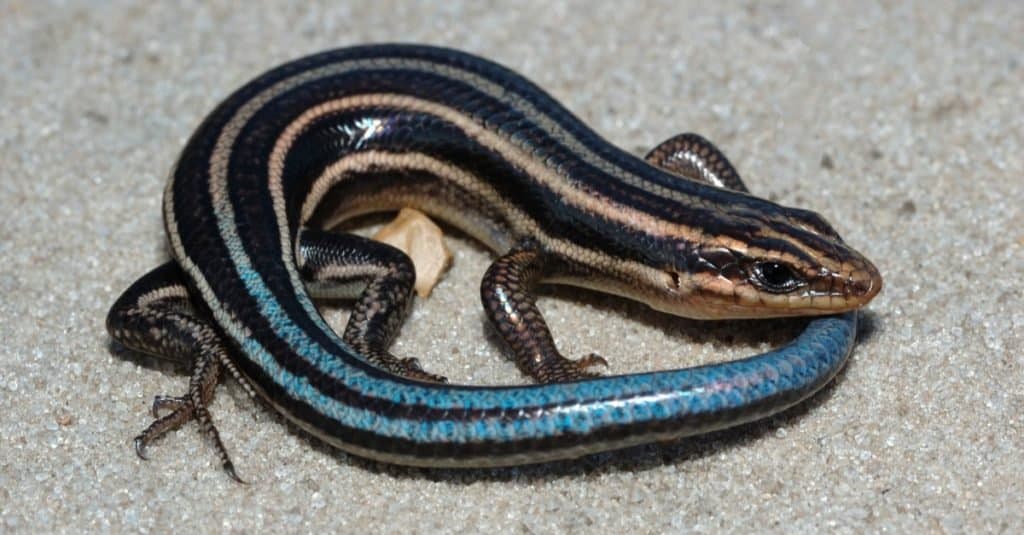
James DeBoer/Shutterstock.com
Skinks are popular pets like many other lizards. One of the issues that pet owners run into with skinks is that it can be hard to replicate their wild diet in captivity. Some skinks are from parts of the world that do not have analogous food sources widely available in the place they’re kept as pets.
Fortunately, skink owners have found that some common food sources everywhere in the world can work for these pets.
Consider the following foods that pet skinks eat when they’re being kept as pets:
- Crickets
- Leafy greens
- Strawberries
- Pinkie mice
- Cockroaches
- Grasshoppers
- Carrots
- Mealworms
- Peas
- Brussel sprouts
- Raspberries
- Mangos
- Cantaloupes
- Some types of canned dog food
- Commercial skink food
These are all foods that many species of skinks can eat when they’re being kept as pets. However, it is necessary to feed skinks food that they would encounter in the wild. Live insects are something that every skink will need, and it helps if they are dusted in bone meal powder beforehand to increase their nutrition.
Depending on the species, pet owners must consider their dietary needs and the types of foods they prefer. That requires consulting exotic pet shops, vets, and reading available literature.
What Competes with Skinks for Food?
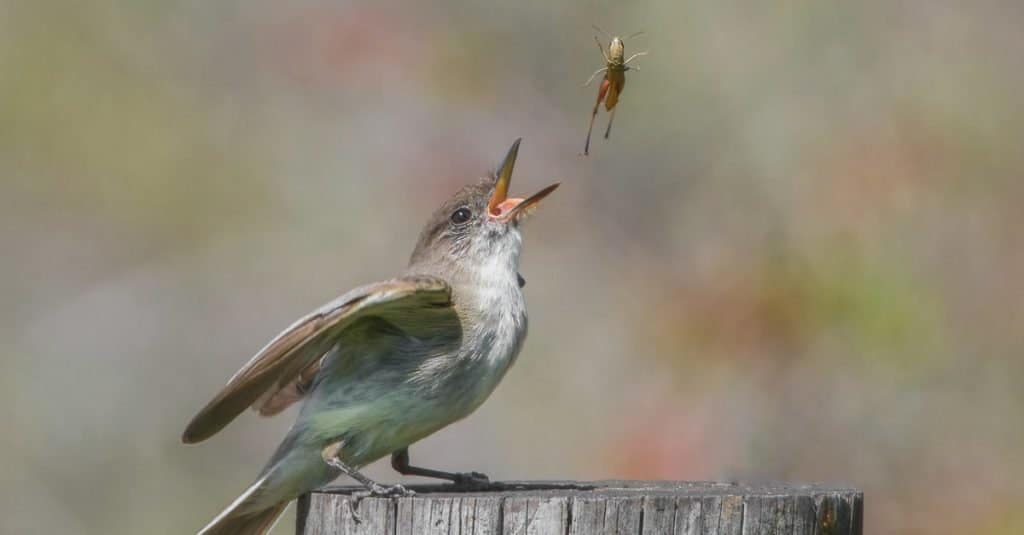
Bearing in mind that skinks eat insects, fruit, small lizards, and some small mammals, it should come as no surprise that they compete with other animals for food. Also, given their large range around the world, various species of skinks come into direct contact with an array of other creatures that have a similar diet.
In some cases, skinks will compete with other skinks for food, but this typically occurs among members of the same species instead of different species that inhabit the same area. For example, a study showed that the sand skink and blue-tailed mole skink, both living in central Florida, did not overlap their eating habits.
However, some of the animals that share the same diet as skinks around the world include:
These are just some of the fellow insectivores and fruit-eaters that can compete with the skink for food. Skinks are not the most effective predators, either. These lizards will resort to drastic measures to find food when it is scarce, with some even eating their own eggs to stay alive.
Skinks have some fierce competition for food in some areas, but insects are plentiful in many of their habitats.
What Predators Eat Skinks?
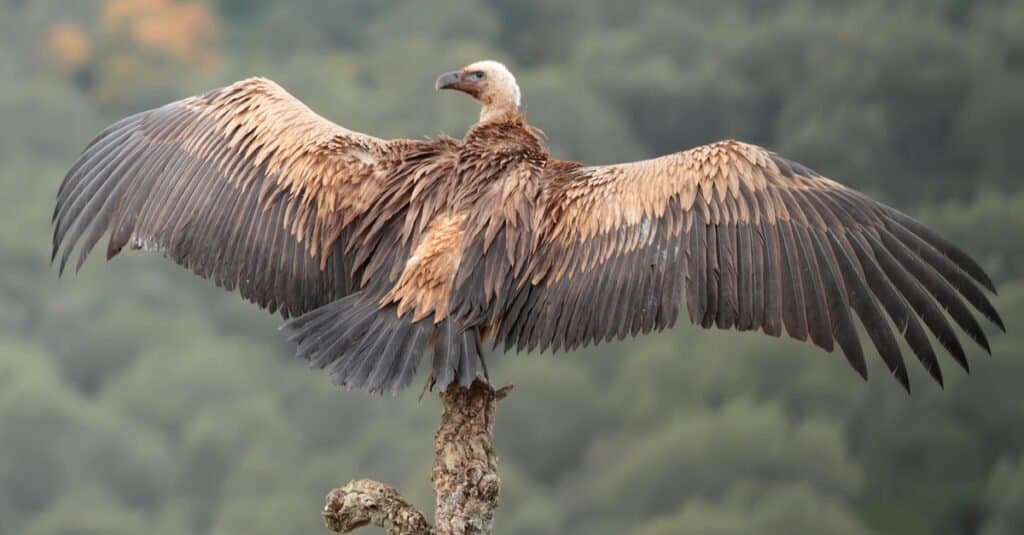
Raul Baena/Shutterstock.com
Skinks may look like snakes to some people, but they lack the venom and ability to constrict would-be predators. Unfortunately, their lack of good defensive measures, aside from willingly shedding their tailes, means skinks are very vulnerable to attacks from other creatures.
- Owl
- Fox
- Snakes
- Raccoons
- Hawks
- Domestic cats
- Domestic dogs
- Robins
- Skinks
- Vultures
As you can see from this list, their enemies often swoop in from the sky, so their ability to smell and pick up ground-based vibrations do them little good. Birds of prey are the most dangerous to skinks in all environments, though other reptiles can also harm them.
The skink is a common reptile that is often kept as a pet. Although they may look like snakes, they share very few behaviors or features with them. Nevertheless, the similarity can spell trouble for skinks since humans often eliminate these creatures first and examine them more closely later.
Skinks are not as capable as snakes or other lizards, but they can still use their unique senses to find food in the wild.
More from A-Z Animals
Skinks are small lizards that have over 1,000 different species around the world. Unfortunately, some of them are confused for snakes in the wild due to their short necks and short legs which makes them take on a serpent-like movement. These reptiles live around the world, and there are notable differences between species in Asia and those in North America. So, what do skinks eat in the wild?
We’ll help you discover the feeding habits of skinks both in the wild and as pets. We’ll also show you how such odd-looking creatures manage to catch food at all!
What Foods Do Skinks Eat?

A-Z-Animals.com
Skinks eat insects, mollusks, small mammals, and fruit. These omnivorous lizards primarily focus on eating insects, but some species will also make fruit a significant portion of their diet. With so many different types of food available to them, the skink’s potential diet is highly varied.
Skinks eat all these foods:
- Flies
- Grasshoppers
- Beetles
- Spiders
- Crickets
- Moths
- Earthworms
- Roaches
- Locusts
- Dandelion greens
- Squash
- Caterpillars
- Termites
- Mango
- Raspberries
- Figs
- Papaya
- Small lizards
- Millipedes
- Mice
- Slugs
- Skink eggs (rarely)
The majority of skinks mostly eat insects as part of their diet. However, given that the skink is not well-adapted to hunt down insects, their diet is somewhat flexible.
The differences between types of skinks can be vast in terms of location and physiology. Some skinks are more lizard-like and capable of chasing down a meal while others are more snake-like, and their locomotion is hindered.
How Do Skinks Hunt?

Kurit afshen/Shutterstock.com
As carnivores, skinks have to spend a fair amount of their time hunting for food. They are opportunistic hunters most of the time, meaning they come across prey and eat. Sometimes, they will ambush prey by exploring various crevices where they believe prey could be, especially in the case of crustaceans by the ocean.
One means that skinks use to find prey is their sense of smell. However, the way they smell other creatures is unique. They will flick their tongue and use the chemical cues they gather to determine what is nearby. They can use this ability to sense prey that is close, and they can also use this ability defensively to see if there is a predator in their area.
Finding insects, fruit, and other small lizards is easy when looking for them according to their chemical markers.
Another way that skinks find food is through a sense of detecting vibrations in the ground like many other reptiles. They sense the ground-borne vibrations of nearby creatures to determine if they are something they eat or a creature from which they need to hide.
Even with these adaptations, skinks are not always fast enough or clever enough to land a good meal.
What Do Pet Skinks Eat?

James DeBoer/Shutterstock.com
Skinks are popular pets like many other lizards. One of the issues that pet owners run into with skinks is that it can be hard to replicate their wild diet in captivity. Some skinks are from parts of the world that do not have analogous food sources widely available in the place they’re kept as pets.
Fortunately, skink owners have found that some common food sources everywhere in the world can work for these pets.
Consider the following foods that pet skinks eat when they’re being kept as pets:
- Crickets
- Leafy greens
- Strawberries
- Pinkie mice
- Cockroaches
- Grasshoppers
- Carrots
- Mealworms
- Peas
- Brussel sprouts
- Raspberries
- Mangos
- Cantaloupes
- Some types of canned dog food
- Commercial skink food
These are all foods that many species of skinks can eat when they’re being kept as pets. However, it is necessary to feed skinks food that they would encounter in the wild. Live insects are something that every skink will need, and it helps if they are dusted in bone meal powder beforehand to increase their nutrition.
Depending on the species, pet owners must consider their dietary needs and the types of foods they prefer. That requires consulting exotic pet shops, vets, and reading available literature.
What Competes with Skinks for Food?

Bearing in mind that skinks eat insects, fruit, small lizards, and some small mammals, it should come as no surprise that they compete with other animals for food. Also, given their large range around the world, various species of skinks come into direct contact with an array of other creatures that have a similar diet.
In some cases, skinks will compete with other skinks for food, but this typically occurs among members of the same species instead of different species that inhabit the same area. For example, a study showed that the sand skink and blue-tailed mole skink, both living in central Florida, did not overlap their eating habits.
However, some of the animals that share the same diet as skinks around the world include:
These are just some of the fellow insectivores and fruit-eaters that can compete with the skink for food. Skinks are not the most effective predators, either. These lizards will resort to drastic measures to find food when it is scarce, with some even eating their own eggs to stay alive.
Skinks have some fierce competition for food in some areas, but insects are plentiful in many of their habitats.
What Predators Eat Skinks?

Raul Baena/Shutterstock.com
Skinks may look like snakes to some people, but they lack the venom and ability to constrict would-be predators. Unfortunately, their lack of good defensive measures, aside from willingly shedding their tailes, means skinks are very vulnerable to attacks from other creatures.
- Owl
- Fox
- Snakes
- Raccoons
- Hawks
- Domestic cats
- Domestic dogs
- Robins
- Skinks
- Vultures
As you can see from this list, their enemies often swoop in from the sky, so their ability to smell and pick up ground-based vibrations do them little good. Birds of prey are the most dangerous to skinks in all environments, though other reptiles can also harm them.
The skink is a common reptile that is often kept as a pet. Although they may look like snakes, they share very few behaviors or features with them. Nevertheless, the similarity can spell trouble for skinks since humans often eliminate these creatures first and examine them more closely later.
Skinks are not as capable as snakes or other lizards, but they can still use their unique senses to find food in the wild.




